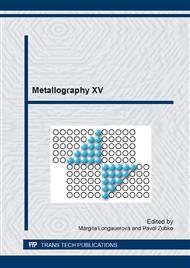p.390
p.394
p.398
p.404
p.408
p.415
p.421
p.427
p.431
Structural Stability of Welded Joints of Magnesium Alloy EZ33A-T5
Abstract:
Magnesium alloys of Mg-Zn-RE-Zr group are characterized by creep resistance up to 250°C, good castability, absence of the microporosity and gas corrosion resistance. Defect of these alloys are low mechanical properties at ambient temperature. Magnesium alloys are used in the automotive, aerospace and defense industries, mainly as gravitational casts to sand moulds or die-casting. Casting defects often appear in these casts (misruns, micro-shrinkage, cracks), especially for large-size castings. The welding technologies are most often applicable to repair of casts, mainly non-consumable electrode welding in the inert-gas cover. Welded joints made of magnesium alloys should have properties at least the same as the ready cast, in particular it should ensure stability of the structure and properties of all welded joint in working temperature. In the literature there is a lack of information about stability and properties of welded joints of Mg-4E-3Zn (EZ33A-T5 acc. to ASTM B80) alloy castings. In research work determined the structure of welded joints of Mg-4RE-3Zn alloy casting after stress-relief annealing and defined changes of structure and properties during long-term annealing at the temperature of 250°C. It was found that the structure of welded joint of casting alloy Mg-4RE-3Zn is stable at the temperature of 250°C through at least 1000 hours. The hardness of tested joints equal 80 HV. Therefore welding technologies can be used for repair of magnesium alloy casts with addition of zinc and rare earth elements.
Info:
Periodical:
Pages:
408-414
Citation:
Online since:
April 2014
Authors:
Keywords:
Price:
Сopyright:
© 2014 Trans Tech Publications Ltd. All Rights Reserved
Share:
Citation:


